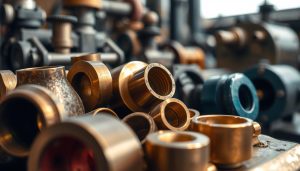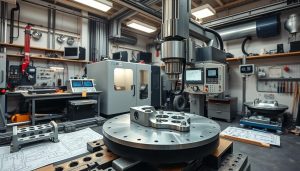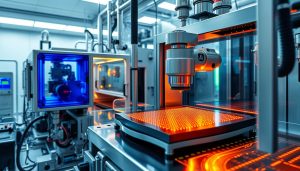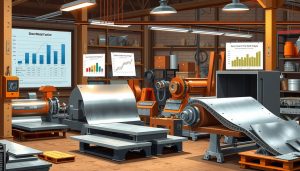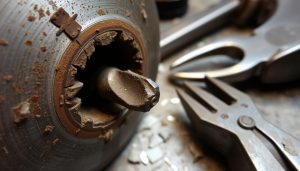In the dynamic world of computer numerical control (CNC) machining, jig fixture design plays a crucial role in ensuring precision, productivity, and efficiency. Whether you’re a seasoned manufacturer or a newcomer to the industry, mastering the art of jig fixture design can unlock a world of benefits for your CNC turning operations. This article delves into the essential tips and best practices that will help you optimize your CNC turning processes through well-designed jigs and fixtures.
Importance of Jig Fixture Design in CNC Turning
Precision and efficiency are the hallmarks of successful CNC turning operations. At the heart of this success lies the critical role of jig fixture design. Crafting well-designed jigs and fixtures is essential for achieving the machining precision, productivity enhancement, and CNC turning success that modern manufacturing demands.
Why Proper Design is Crucial for CNC Turning Success
Proper jig fixture design ensures the precise positioning and secure clamping of workpieces during CNC turning. This attention to detail translates directly into improved accuracy, reduced setup times, and increased overall efficiency in the machining process. Poorly designed fixtures, on the other hand, can lead to workpiece instability, tooling interference, and other issues that compromise product quality and consistency.
Key Benefits of Well-Designed Jigs and Fixtures
- Enhanced machining precision and part accuracy
- Reduced setup times and increased productivity
- Improved surface finishes and consistency in manufactured parts
- Minimized risk of errors and defects during CNC turning operations
- Increased safety and ergonomics for machine operators
By investing in the right jig fixture design, manufacturers can unlock the full potential of their CNC turning capabilities, delivering high-quality products with greater efficiency and cost-effectiveness.
“Proper jig fixture design is the foundation for achieving machining precision and productivity enhancement in CNC turning operations.”
Types of Jigs and Fixtures for CNC Turning
When it comes to CNC turning, the choice of jigs and fixtures plays a crucial role in ensuring accurate and efficient workpiece positioning. Two primary categories of CNC turning fixtures are standard fixtures and custom fixtures, each with their own unique advantages.
Standard vs. Custom Fixtures
Standard CNC turning fixtures are pre-engineered, off-the-shelf solutions that offer a cost-effective and time-saving option for many CNC turning operations. These fixtures are designed to accommodate a wide range of workpiece sizes and shapes, making them a versatile choice for manufacturers. On the other hand, custom fixtures are tailored to the specific requirements of a particular workpiece or production process, offering enhanced stability, precision, and repeatability.
The decision to use standard or custom CNC turning fixtures often depends on factors such as the complexity of the workpiece, production volume, and the required level of accuracy. For high-volume, less complex parts, standard fixtures may be the optimal choice, while custom fixtures are typically employed for intricate or specialized components that demand tighter tolerances.
The Role of Jigs in CNC Turning
- Jigs are essential tools in CNC turning operations, as they help to accurately position and secure the workpiece during the machining process.
- By utilizing precise locating and clamping mechanisms, jigs ensure that the workpiece is held in the correct orientation, minimizing the risk of errors and improving overall machining accuracy.
- Jigs also play a crucial role in reducing setup time, as they provide a consistent and repeatable method for preparing the workpiece for machining.
The strategic use of both standard and custom jigs and fixtures in CNC turning can significantly enhance productivity, quality, and cost-effectiveness, making them an integral part of any successful CNC turning operation.
“Proper jig and fixture design is the foundation for achieving high-precision CNC turning results. It’s a critical step that shouldn’t be overlooked.”
Best Practices for Designing Effective CNC Jigs and Fixtures
Crafting well-designed jigs and fixtures is a crucial aspect of successful CNC turning operations. By following proven best practices, manufacturers can ensure the stability, precision, and efficiency of their CNC machining processes. Let’s explore three key elements to consider when designing effective CNC jig and fixture solutions.
Correct Placement of Clamps and Locators
The strategic positioning of clamps and locators is paramount for securing the workpiece and maintaining its alignment during the machining process. Carefully analyze the part geometry and anticipated cutting forces to determine the optimal clamping points. Utilize multiple clamps, distributed evenly across the workpiece, to provide a stable and secure hold. Locators should be placed to support the part at crucial reference points, minimizing any potential for movement or distortion.
Material Selection: Ensuring Durability and Precision
The choice of materials for your fixture design can significantly impact the long-term performance and accuracy of your CNC jigs and fixtures. Opt for durable, high-quality materials that can withstand the rigors of the machining environment, such as hardened steel, aluminum, or engineered composites. These materials not only provide the necessary strength and rigidity but also maintain dimensional stability, ensuring precise part positioning throughout the production run.
Minimizing Setup Time and Improving Efficiency
Efficient CNC jig and fixture design can greatly contribute to reducing setup times and enhancing overall machining productivity. Incorporate features that enable quick and easy workpiece loading and unloading, such as quick-release mechanisms or modular components. Additionally, design the jigs and fixtures to be compatible with your CNC machine tool, minimizing any potential for interference with the cutting tools or spindle movement.
By following these best practices for CNC jig design and fixture development, manufacturers can unlock the full potential of their CNC turning operations, ensuring consistent part quality, improved throughput, and enhanced overall efficiency.

Common Challenges in CNC Jig Fixture Design
Designing effective CNC jigs and fixtures is a critical aspect of ensuring successful and efficient machining operations. However, there are several common challenges that can arise during the fixture design process. Understanding these obstacles and implementing effective strategies to overcome them can significantly improve the overall performance of CNC turning applications.
Overcoming Stability and Alignment Issues
One of the primary challenges in CNC fixture design is ensuring the stability and proper alignment of the workpiece. Improper placement or inadequate support can lead to vibrations, deflections, and other issues that compromise the accuracy and precision of the machining process. To address these stability issues, designers must carefully consider the placement and design of clamps, locators, and other fixture components to provide a secure and stable platform for the workpiece.
Dealing with Tooling Interference
Another common CNC fixture design challenge is managing tooling interference. The complex movements and interactions between the cutting tools, the workpiece, and the fixture can sometimes result in collisions or obstructions, which can damage the tools, the workpiece, or the fixture itself. To mitigate these alignment problems, designers must carefully plan the tool paths and optimize the fixture configuration to ensure unimpeded access and movement during the machining process.
| Challenge | Description | Possible Solutions |
|---|---|---|
| Stability Issues | Workpiece vibrations, deflections, and alignment problems |
|
| Tooling Interference | Collisions and obstructions between cutting tools, workpiece, and fixture |
|
By understanding and effectively addressing these common CNC fixture design challenges, manufacturers can ensure the stability, alignment, and interference-free operation of their CNC turning operations, leading to consistent and high-quality machining results.

Shixinproto’s CNC Machining and Fixture Design Services
At Shixinproto, we take pride in our exceptional CNC machining services and comprehensive fixture design solutions. Our team of skilled engineers and designers are dedicated to helping manufacturers like you overcome complex machining challenges and optimize their CNC turning operations.
Whether you require custom jig manufacturing or need assistance with designing effective CNC fixtures, Shixinproto has the expertise and resources to deliver tailored solutions that meet your specific requirements. We understand the crucial role that well-designed jigs and fixtures play in ensuring the success of your CNC turning processes, and our comprehensive approach ensures that every aspect of your project is addressed with precision and attention to detail.
By partnering with Shixinproto, you can unlock the full potential of your CNC machinery and experience the benefits of improved productivity, increased accuracy, and reduced setup times. Our commitment to innovation and customer satisfaction has earned us a reputation as a trusted industry leader in CNC machining and fixture design. Let us help you take your CNC turning capabilities to new heights.
FAQ
What is the importance of proper jig fixture design in CNC turning?
What are the different types of jigs and fixtures used in CNC turning?
What are some best practices for designing effective CNC jigs and fixtures?
- Proper placement of clamps and locators for optimal workpiece stability.
- Selecting durable and precise materials for fixtures.
- Minimizing setup time to enhance machining efficiency.

